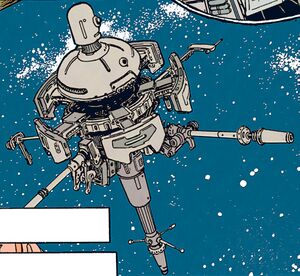Hyperspace beacon/Legends

- "It's taken almost twenty-thousand years to accurately chart the hyperspace lanes, Master Andur. Without these jump beacons to guide us, faster-than-light travel would be too risky."
- ―A-3DO
Hyperspace beacons, also known as jump beacons, were used as fixed navigation points for hyperspace travel c. 4000 BBY. Examples include the Stenness Hyperspace Terminal, Belgoth's Beacon, and Darknon Station, and probably Terman Station, as well. Pirates and Hutts sometimes reprogrammed the beacons to transmit incorrect coordinates to ships, sending them into deep space so the ships could be ambushed and pillaged far from the interference of the Republic.
History
They were known to be in use in the Tion Cluster as early as 25,100 BBY which means they were contemporary to the Corellian and Duros hyperspace cannon. The Tionese developed their hyperdrive technology from knowledge gained by Rakata castoffs of the Cluster. This limited hyperdrive made use of this "lighthouse network" consisted by fixed-position beacons.[2]
Beacons recorded local hyperspace data, which was then downloaded by visiting spacecraft. Each beacon was a massive supercomputer in space that kept accurate data on routes to a limited number of other beacons, providing practical limitations on hyperspace jumps in both distance and direction.[2] A local network might require as many as twenty jump beacons, with an individual beacon transmitting astrogational information from a ship to the rest of the network.[2]
The beacons were maintained and patrolled by the Republic Spacelane Bureau. Reliability of available data was only about 80%. Beacons were moored in open space between systems to avoid the effects of gravitation.
Around the time of the Mandalorian Wars, the beacons became redundant with the introduction of navicomputers, which were then capable of storing millions of hyperspace routes or of restricted (e.g., military or political) navigational data,[2] although certain sectors with notoriously difficult navigational routes, like the Tapani sector, continued to utilize hyperspace beacons well into the Imperial Period.
There were rumors that ancient beacons were used in Hutt Space to guide their slave ships.[2]
Behind the scenes
Hyperspace beacons featured prominently in the Tales of the Jedi series, and were apparently necessary for all hyperspace travel during the events of the Great Sith War. However, by the time of the Knights of the Old Republic comics and computer games, hyperspace-capable craft contained autonomous navigation computers or were assisted by astromech droids.
Appearances
- Crosscurrent
- Lost Tribe of the Sith: Precipice (Mentioned only)
- Star Wars: Tales of the Jedi — The Saga of Nomi Sunrider (First appearance)
- Tales of the Jedi (audio)
- Star Wars: The Old Republic: Rise of the Hutt Cartel
- Star Wars: The Old Republic: Galactic Starfighter
- Darth Plagueis (Mentioned only)
- Darth Plagueis audiobook (Mentioned only)
Sources
 "Straight from the Horse's Mouth: A Guide to the Star Wars: Tales of the Jedi Universe, Part 2" – Star Wars Insider 27
"Straight from the Horse's Mouth: A Guide to the Star Wars: Tales of the Jedi Universe, Part 2" – Star Wars Insider 27- Platt's Starport Guide
- Tales of the Jedi Companion
- Pirates & Privateers
- Star Wars Insider 27
- Cynabar's Fantastic Technology: Droids
- Lords of the Expanse
- Player's Guide to Tapani
- Star Wars: The Official Figurine Collection 53 (High-Speed Travel: Hyperspace Routes)
- The New Essential Chronology
- The New Essential Guide to Droids
- The Complete Star Wars Encyclopedia (As "jump beacon," "jump gate")
- The Essential Atlas
 Essential Atlas Extra: The History of Xim and the Tion Cluster on StarWars.com (article) (backup link not verified!)
Essential Atlas Extra: The History of Xim and the Tion Cluster on StarWars.com (article) (backup link not verified!)- The Unknown Regions
- The Essential Guide to Warfare
- Star Wars: Edge of the Empire Core Rulebook
Notes and references
- ↑ Tales of the Jedi (audio)
- ↑ 2.0 2.1 2.2 2.3 2.4 The Essential Atlas, p.13